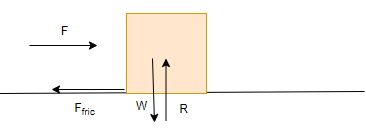

Answer is (a)
Acceleration will be one -fourth
It is because of the inertia of rest of the leaves .Leaves tend to remain at rest whereas the branch comes into motion,this causes the leaves to fall down
Given u =5 m/s , v=8 m/s ,t=6 s ,m=100 kg
Momentum is given by
$p=mv$
Initial Momentum ($p_1$)
$p_1 =mu = 100 \times 5 = 500 kgm/s$
Final Momentum ($p_2$)
$p_2 =mv = 100 \times 8 = 800 kgm/s$
Now Force can be calculated as
$f= \frac {\Delta p}{t} = \frac {800-500}{6} = 50N$
We know that formula for these quantities in Free fall
Acceleration $g$. Acceleration in free fall is constant and it is given by g= 9.8 m/s2
Force $F=ma$ .So it will be different for large or small bodies
Velocity $ v= u + at$ . This will keep changing with time
Momentum $p= mv$. This will also keep on changing
We can easily see that Force,velocity ,momentum will be different. The only thing which is constant is acceleration
Action- when the runner presses the ground with his feet before starting to run
Reaction- when the runner moves forward due to the forward force applied by the ground on him
runs before jumping to gain momentum. Because it helps in jumping higher and longer because of inertia of motion gained due to the motion.
When the athletes Jump they already have a forward motion that would be greater than that of a jump made from standing in one spot.
Action and reaction forces are equal in magnitude and opposite in direction
$F= \frac {\Delta}{t}$
$p=mv$
$v=\frac {p}{m}$
We can easily see that with same momentum, light object will be travelling faster
a. Change in shape
b. change in velocity and direction
c. change in shape

i. Forces acting on the Horizontal box
a. Reaction of the surface on the box in Upward direction
b. Weight of the box in the vertical direction
c. Push force in the horizontal forward direction
d. Friction force in the horizontal backward direction and it is dependent on the roughness of the horizontal surface and weight of the box

The box will start moving when the horizontal applied force is greater then friction force
ii.
a.Friction force will increase in case the weight of the box is increase, so horizontal applied force will need to be increased
b. Friction force will increase in case the surface is made more rough, so horizontal applied force will need to be increased
s=19.6 m , a= g=9.8 m/s2, u=0, v=?
$v^2=u^2 + 2as$
$v^2 = 2 \times 9.8 \times 19.6= 19.6 \times 19.6$
v=19.6 m/s
a. As per law of conservation of momentum
$0 = 3 v + .03 \times 100$
or v = -1 m/s
b. Force exerted on gunman due to recoil of the gun will be equal force exerted on the bullet.
Now for bullet, u=0 , v=100 m/s , t=.003 sec
$a= \frac {v-u}{t} = 3333.33 m/s^2$
Total force on bullet = .03 \times 3333.33 = 100 N
This same force will b exerted on the gunman due to recoil of the gun
(i) The SI (International System of Units) unit of force is the newton, symbolized by "N." One newton is defined as the force required to accelerate a one-kilogram mass at a rate of one meter per second squared.
(ii) Given values:
\[ u = 2 \, \text{m/s} \]
\[ v = 5 \, \text{m/s} \]
\[ t = 10 \, \text{s} \]
\[ F = 2 \, \text{N} \]
1. Find acceleration (\(a\)) using the equation \(v = u + at\):
\[ v = u + at \]
\[ 5 = 2 + a \times 10 \]
Solve for \(a\):
\[ a = \frac{5 - 2}{10} = \frac{3}{10} = 0.3 \, \text{m/s}^2 \]
2. Now, use Newton's second law (\(F = ma\)) to find the mass (\(m\)):
\[ F = m \cdot a \]
\[ 2 = m \cdot 0.3 \]
Solve for \(m\):
\[ m = \frac{2}{0.3} \approx 1.33 \, \text{kg} \]
So, the correct mass of the body is approximately \(1.33 \, \text{kg}\).
Reason is given as
When a moving bus suddenly stops, the luggage on its roof still tends to continue in the state of motion due to inertia of motion. Thus, to avoid the falling of the luggage, it is tied with a rope on the roof of a bus.
a. Momentum is defined as the product of mass and velocity and it is a vector quantity. SI unit of momentun is kg m/s
b. Applying law of conservation of momentum
$0=7.5v + .02 \times 200$
v=-.53 m/s
a. It can change the speed of the object. A ball slows down on the surface due to friction
b. it can change the direction of the object. In cricket,batsman hit the ball to change the direction of ball
c. It can change the shape of the object. Example stretched spring
When the book slides down the table top, two forces are acting
a. Friction force in upward direction
b. Gravitational force in downward direction.
The two forces are not equal and thus unbalanced force is there which moves the book downward.
Frictional force is responsible for bringing the book to rest position after certain distance after sliding
This happens because of inertia of direction. When the bicycle wheel rotates, centripetal force is not exerted on the mud particles, so mud particles because of inertai of direction continue to move in straight line tangential to the wheel
This can again be explained on the basis of the law of inertia. We tend to continue in our straight-line motion. When an unbalanced force is applied by the engine to
change the direction of motion of the motorcar, we slip to one side of the seat due to the inertia of our body
a. In hard surface, the body comes to rest in shorter time the fall on cotton or sand, so force is more
b. The gun exerts force on the bullet.Now by Newton third law, an equal and opposite force acts on the gun and which is turn is exerted on the gunman
c. When the bullet strikes the glass window, the part of the glass window which comes in contact with the bullet immediately shares the large velocity of bullet and makes a hole, while the remaining part of the glass remains at rest and is therefore not smashed due to inertia of rest.
But when a slow moving stone strikes the same glass window, the various parts of the glass window gets enough time to share the velocity of the stone, and the glass is smashed.
m=1 kg,u=20 m/s ,a=? , s=50 m ,v=0
$v^2 = u^2 + 2as$
a= -4 m/s2
Force of friction = $1 \times 4 =4 N$
ii. s= 5m , a= g=10 m/s2 ,u=0, v=?
$v^2= u^2+ 2as$
v= 10 m/s
Momentum of object when it touches the floor = $10 \times 10 = 100 kg m/s$
This same momentum will get tranferred to the floor
iii.karate player strikes the pile with his hand very fast. The large momentum of his hand is reduced to zero in a very short time. This exerts a large force on the pile of tiles which is sufficient to break them apart.
a. The runner pushes the ground with his feet and in turns , the ground applies the force on the runner to starts his run
b. When the boat manexerts a force of action on the bank with his ore, the bank exerts an equal and opposite force of reaction on the boat. Hence, the boat moves away from the bank.
By using law of conservation of momentum
$m_1 u_1 + m_2 u_2 = (m_1 + m_2) v$
$60 \times 3 + 140 \times 1.5 = (60 + 140)v$
v=1.95 m/s

b. As per law of conservation of momentum
$1000 \times 5 - 1000 \times 5 = 2000v$
or v=0
a. $p=mv$ and SI unit is kg m/s
b. Since car is having less mass then truck ,velocity of car will be more
c. m= 20 g= .002 kg ,u=500 m/s , M= 1kg
Now
$mu = (M+m) v$
$ .02 \times 500 = (1.02) v$
or v= 9.8 m/s
a. As per law of conservation of momentum, When two or more bodies acts upon each other their total momentum remains constant provided no external forces are acting
Initial Momentum
$p_1 = m_1 u_1 + m_2 u_2$
Final Momentum
$p_2 = m_1 v_1 + m_2 v_2$
Now
$p_1 =p_2$
$m_1 u_1 + m_2 u_2= m_1 v_1 + m_2 v_2$
b. m= 500g = .5 kg , u=50 m/s ,t=.01 s, v=0 ,a=?
$\Delta p = p_2 - p_1 = mv - mu= -25 kg m/s
$v=u+at$
a=-5000 m/s2
Force of Hammer=$ ma= .5 \times 5000= 2500 N$
Force of Nail= Force on Hammer= 2500N
We have basically three types of Inertia-:
(a) Inertia of Rest: This is the resistance offered by body to change its state of rest
Examples:
(i) Person sitting in a car falls backwards, when the car suddenly starts. It is because the lower portion in contact with the car comes in motion where as the upper part tries to remain at rest due to inertia of rest.
(ii)When a carpet is beaten with a stick then the dust particles due to inertia of rest tends to remain in rest while the fibers of carpet becomes in motion.
(b) Inertia of Motion:This is the resistance offered by body to change of uniform motion is known as Inertia of motion.
Examples:
(i) When a moving car suddenly stops the person sitting in the car falls forward because the lower portion of the body in contact with the car comes to rest whereas the upper part tends to remain in motion due to inertia of motion.
(ii) An athlete runs a certain distance before taking a long jump because the velocity acquired by running is added to the time of jump, so that it can cover a long distance.
(c) Inertia of Direction: This is the resistance offered by body to change its direction of motion.
Examples:
(i) When a car moves round a curve the person sitting inside is thrown outwards in order to maintain his direction of motion due to inertia of motion
i. Momentum is defined as the product of mass and velocity and it is a vector quantity. SI unit of momentun is kgm/s
ii. u= 4 m/s ,v=8 m/s ,t=8 sec, a=?
$v=u+at$
a= .5 m/s2
Initial Momentum = $50 \times 4 = 200 kgm/s$
Final Momentum = $50 \times 8 = 400 kgm/s$
Force exerted = $ma = 50 \times .5 = 25 N$
Solution
Law of conservation of momentum - This law states that if a number of bodies are interacting with each other, their total momentum remains conserved before and after the interaction, provided there is no external force acting on them.
p1+p2=p'1+p'2
Derivation of Law of Conservation of Momentum from Newton's Second Law -
Suppose p1 and p2 represent the sum of momentum of a group of objects before and after the collision respectively. Let t is time elapsed during collision. Then according to Newton's Second Law,
External force = Rate of change of momentum
or,
\( F = \frac{{p_2} - {p_1}} {t} \)
If there is no external force, F=0 and
\( \frac {{p_2} - {p_1}} {t} = 0 \)
or, p1=p2
Therefore in the absence of an external force, the total momentum of a group of objects remains unchanged or conserved during collision. This is the law of conservation of momentum.
This Extra questions on Force ,Momentum and Laws of Motion for Class 9 Physics is prepared keeping in mind the latest syllabus of CBSE . This has been designed in a way to improve the academic performance of the students. If you find mistakes , please do provide the feedback on the mail.